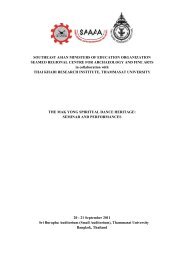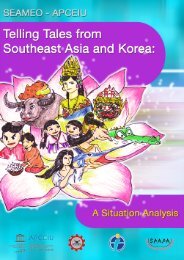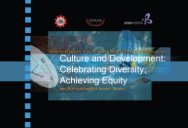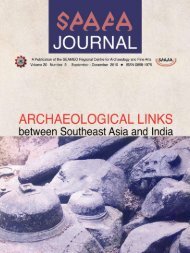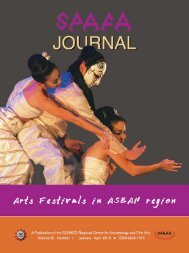Perspectives on Heritage Tourism - Seameo-SPAFA
Perspectives on Heritage Tourism - Seameo-SPAFA
Perspectives on Heritage Tourism - Seameo-SPAFA
Create successful ePaper yourself
Turn your PDF publications into a flip-book with our unique Google optimized e-Paper software.
<str<strong>on</strong>g>Perspectives</str<strong>on</strong>g> <strong>on</strong> <strong>Heritage</strong> <strong>Tourism</strong><br />
<str<strong>on</strong>g>Perspectives</str<strong>on</strong>g> <strong>on</strong> <strong>Heritage</strong> <strong>Tourism</strong><br />
Part of the artists’ goal was to re-educate people who just focus<br />
<strong>on</strong> business. The artists’ message is that in the broader c<strong>on</strong>text,<br />
retaining heritage sites adds value to the community and to tourism.<br />
A good example of the staunch heritage advocates is the late<br />
Mr. Kuo Pao Kun, a playwright, theatre director, and arts activist”<br />
in Singapore who wrote and directed both Mandarin and English<br />
plays. He founded three arts and drama centres in Singapore,<br />
c<strong>on</strong>ducted and organised a number of drama seminars and workshops,<br />
and mentored Singaporean and foreign directors and artists.<br />
Kuo Pao Kun<br />
Photo: The Substati<strong>on</strong><br />
The Substati<strong>on</strong><br />
Photo: The Substati<strong>on</strong><br />
Pao Kun was <strong>on</strong>e of the leading prop<strong>on</strong>ents of<br />
black box theatre and artists. In 1990, he took a<br />
landmark step to renovate a heritage site by<br />
c<strong>on</strong>verting an old and unused power substati<strong>on</strong><br />
based in Armenian Street into what became<br />
Singapore’s first independent c<strong>on</strong>temporary arts<br />
centre known as The Substati<strong>on</strong>. His aim for The<br />
Substati<strong>on</strong> was to nurture local artists and to serve<br />
as a community-run arts centre for workshops,<br />
c<strong>on</strong>certs, lectures, and exhibiti<strong>on</strong>s. With this<br />
project, he showcased clearly<br />
how the preservati<strong>on</strong> of a heritage<br />
building could advance a<br />
new business approach that<br />
caters to the public and tourists<br />
who are interested in the<br />
arts. His example, which gained<br />
prominence in 1999, set the<br />
trend am<strong>on</strong>g arts-related businesses<br />
of c<strong>on</strong>verting old buildings<br />
into art centres.<br />
Another notable example is the c<strong>on</strong>versi<strong>on</strong> of the old Singapore<br />
Parliament House into a performance space currently called The<br />
Arts House. Al<strong>on</strong>g with this is the preservati<strong>on</strong> of a precious<br />
fragment of the history of Singapore involving a significant but<br />
largely unknown landmark of a br<strong>on</strong>ze elephant statue. This statue<br />
was given to Singapore by King Chulal<strong>on</strong>gkorn the Great as a token<br />
of appreciati<strong>on</strong> after his visit <strong>on</strong> 15 March 1871, marking the first<br />
visit of a Siamese king to a foreign nati<strong>on</strong>, a historic reminder that<br />
still sits in fr<strong>on</strong>t of the old Parliament House today.<br />
The Red House Museum is another heritage site that now serves as<br />
a design museum, with parts of its space rented out to restaurants.<br />
Established in 2000, it was c<strong>on</strong>verted from a 1920s col<strong>on</strong>ial building<br />
that used to house the Traffic Police Headquarters. The Red House<br />
Museum is not <strong>on</strong>ly a key attracti<strong>on</strong> but also a hub for creative and<br />
lifestyle businesses.<br />
Drawing from the examples<br />
above, certain arts-related businesses<br />
have flourished and made<br />
a mark in the local arts scene<br />
in Singapore. With acceptable<br />
rents for old heritage spaces,<br />
a good lease, some support<br />
from the Nati<strong>on</strong>al Arts<br />
C o u n c i l o f S i n g a p o re ,<br />
these arts groups and arts<br />
companies grew and became<br />
profitable. However, with<br />
such emphasis <strong>on</strong> ec<strong>on</strong>omic<br />
viability, arts groups or organi-<br />
The Red House Museum<br />
Photo: The Red House Museum<br />
88<br />
89



